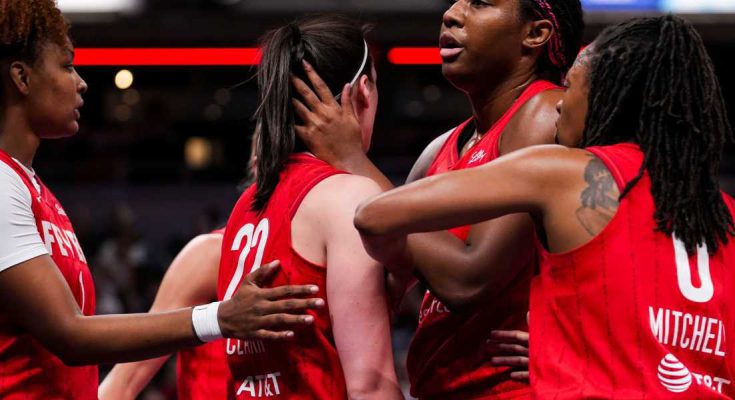The WNBA has been enjoying a surge of attention in recent years, and the Indiana Fever have been right at the center of that movement thanks to a combination of rising stars, historic performances, and the kind of fan enthusiasm that keeps the league’s momentum building. After a recent Fever game, one WNBA team made an announcement that has generated a lot of excitement not just within its own fan base but across the entire women’s basketball community. The good news has added to the growing narrative that the WNBA is entering a new era, where every storyline carries significance and where the league is expanding in reach, reputation, and relevance. This announcement, made in the immediate aftermath of the Fever’s game, highlights how far the WNBA has come and how much potential still lies ahead.
To understand why this news matters, it helps to look at the backdrop of the Fever’s season and the WNBA landscape at large. The Fever have been one of the most discussed teams in the league over the last year, largely because of their rookie sensation Caitlin Clark, whose arrival in Indiana has brought unprecedented media coverage and sold-out arenas across the league. Every time the Fever play, it becomes an event. Crowds gather hours before tipoff, television ratings spike, and the conversation across sports media inevitably gravitates toward the impact of a single game. When another WNBA team takes the opportunity to announce something significant after a Fever game, it demonstrates the ripple effect Indiana has had on the entire league. Teams understand the visibility and the attention that comes from associating their announcements with moments that involve the Fever, and this is exactly what happened when the good news was shared.
The timing was intentional, but the substance of the announcement is what truly made headlines. The team in question revealed an initiative that speaks directly to the league’s growth trajectory: expansion in fan engagement, increased ticket sales, and a commitment to building on the momentum generated by games like the one against the Fever. For years, one of the biggest criticisms of women’s sports has been that they struggle to maintain consistent attendance and media coverage. But the recent surge, amplified by players like Clark, Angel Reese, and veterans such as A’ja Wilson and Breanna Stewart, has transformed that perception. The team’s announcement after the Fever game underscored the idea that women’s basketball is not just surviving—it is thriving.
The good news was centered on a record-breaking milestone. The team reported that ticket sales for their upcoming home stretch had reached a level never before seen in their franchise history. What might once have been a modest attendance figure has now transformed into packed arenas, with fans clamoring for seats well in advance of game day. This mirrors what has been happening league-wide, where sellouts are becoming increasingly common and arenas that were once half-filled now host full-capacity crowds. The announcement was more than just numbers; it was a celebration of progress. For players who have long competed in front of smaller audiences, this surge in fan interest is vindication of their talent, hard work, and the belief that women’s basketball deserves equal footing in the sports conversation.
The impact of this development extends beyond the basketball court. When a WNBA team announces strong ticket sales and record-breaking attendance, it signals to sponsors, broadcasters, and investors that the product is worth supporting. Sports operate in cycles of perception, and momentum can change the trajectory of a league almost overnight. With television networks giving more primetime coverage to games, merchandise sales skyrocketing, and athletes gaining more name recognition, the WNBA’s future has never looked brighter. The announcement after the Fever game was yet another building block in this transformation. Fans who tuned in or attended the Fever matchup left the arena with more than just memories of the game—they also carried forward the energy of the good news that followed.
From a cultural standpoint, this kind of announcement matters deeply. For decades, women’s sports have had to fight for legitimacy and attention. While male athletes in the NBA or NFL were accustomed to sold-out arenas and multimillion-dollar broadcast deals, WNBA players were grinding in the shadows. Many took overseas contracts to supplement their income, and the league fought year after year to secure financial stability. Now, with players emerging as household names and fan bases showing unprecedented loyalty, announcements like these serve as a declaration that women’s basketball has arrived in the mainstream. It also sets an example for future generations of players who dream of making it to the professional level. A young girl watching the Fever game and hearing the announcement afterward would not just see role models on the court but also recognize that the league they aspire to join is growing in stature and opportunity.
Another dimension to this story is the role of the Fever in catalyzing these moments. Caitlin Clark’s arrival has transformed not just the Fever but the entire WNBA ecosystem. Teams that previously might have drawn modest crowds are now experiencing sellouts whenever Indiana comes to town. Media outlets that once relegated WNBA highlights to secondary slots now lead with them, knowing the public is engaged. The announcement after the Fever game illustrates how other franchises are benefiting from the Fever’s draw. They are using the spotlight to highlight their own growth and achievements. This creates a win-win scenario where the league’s collective profile rises, and every team gets to share in the spotlight.
The psychological boost for players should not be overlooked either. Competing in front of packed arenas brings an energy that athletes feed off. When they step onto the court and feel the roar of thousands of fans, it elevates their performance and enhances the spectacle for those watching at home. The announcement about record ticket sales gave players validation that the hours spent training, traveling, and competing are resonating with people on a larger scale than ever before. For veterans who have been in the league since its early years, this represents a fulfillment of a dream they may have once thought would never materialize. For rookies and younger players, it sets a standard of what the WNBA can and should be moving forward.
Financially, the implications are massive. Teams that once struggled to generate revenue are now finding themselves in advantageous positions. Sponsors are more eager to attach their names to franchises that can guarantee visibility. Media rights deals are likely to become more lucrative as networks see consistent ratings growth. Merchandise tied to players is selling out at record speed, with jerseys of stars like Clark, Reese, Wilson, and Stewart ranking among the top sellers. All of these factors compound to create a healthier, more sustainable league. The announcement after the Fever game about record-breaking attendance was not just about one team’s success; it was a signal that the business model of the WNBA is becoming increasingly viable.
The fan reaction to the announcement was immediate and overwhelming. Social media buzzed with excitement as fans celebrated the progress. Supporters who have been following the WNBA for years expressed pride in seeing the league finally get the recognition it deserves. New fans, drawn in by the excitement around the Fever and other emerging stars, expressed eagerness to attend games and be part of the movement. The emotional connection between players and fans has always been one of the WNBA’s strongest assets, and announcements like these deepen that bond. Fans feel invested not just in individual teams but in the league’s success as a whole.
What’s particularly interesting is how this announcement fits into the broader sports landscape. The WNBA is not growing in isolation; it is part of a wider societal shift toward valuing women’s sports. From soccer to tennis to basketball, women athletes are drawing larger crowds and commanding more attention. Major corporations are aligning themselves with these athletes because they see both social and financial value in doing so. The announcement after the Fever game contributes to this narrative, adding another data point that women’s sports are no longer niche but mainstream.
Looking ahead, the good news sets the stage for even more ambitious goals. If one team can set attendance records following a Fever matchup, others are sure to follow. Expansion discussions, which have been simmering for years, are likely to gain more traction as the league demonstrates it can sustain high demand. Cities across the country that have long wanted a WNBA team may now be closer to seeing their dreams realized. For the league office, announcements like this provide leverage in negotiations with broadcasters and sponsors. For players, it creates optimism that salaries, benefits, and overall working conditions will continue to improve.
In many ways, the announcement was symbolic of the WNBA’s journey. For years, the league has fought for visibility, for respect, and for a chance to thrive. Now, in the wake of a Fever game that drew massive attention, a team stood up and shared tangible evidence that things are changing for the better. It wasn’t just good news; it was validation, inspiration, and motivation all wrapped into one. Fans walked away with a sense that they are part of something historic, players felt the momentum pushing them forward, and the league as a whole gained another reason to believe that the future is bright.
The WNBA is on the cusp of a breakthrough era, and every announcement like this brings it closer. The Indiana Fever may be the catalyst, but the ripple effects are lifting every team in the league. The good news announced after that Fever game will be remembered not just as a milestone for one franchise but as a marker of how far the WNBA has come and where it is heading. It is a reminder that when the lights shine brightest, women’s basketball is ready to rise to the occasion and prove that it belongs at the center of the sports world.



